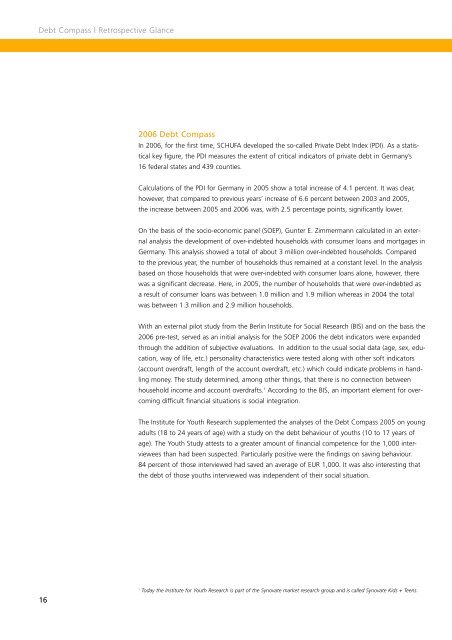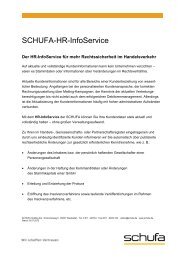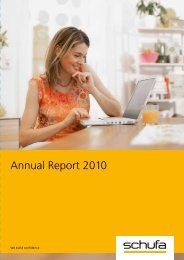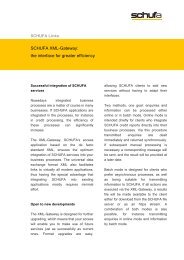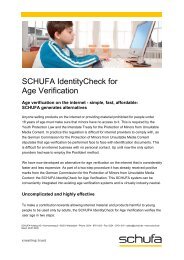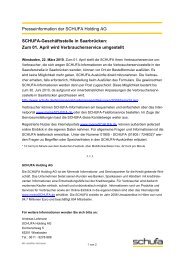Abridged English version of the SCHUFA Credit Compass 2008
Abridged English version of the SCHUFA Credit Compass 2008
Abridged English version of the SCHUFA Credit Compass 2008
Create successful ePaper yourself
Turn your PDF publications into a flip-book with our unique Google optimized e-Paper software.
Debt <strong>Compass</strong> | Retrospective Glance<br />
16<br />
2006 Debt <strong>Compass</strong><br />
In 2006, for <strong>the</strong> first time, <strong>SCHUFA</strong> developed <strong>the</strong> so-called Private Debt Index (PDI). As a statistical<br />
key figure, <strong>the</strong> PDI measures <strong>the</strong> extent <strong>of</strong> critical indicators <strong>of</strong> private debt in Germany’s<br />
16 federal states and 439 counties.<br />
Calculations <strong>of</strong> <strong>the</strong> PDI for Germany in 2005 show a total increase <strong>of</strong> 4.1 percent. It was clear,<br />
however, that compared to previous years’ increase <strong>of</strong> 6.6 percent between 2003 and 2005,<br />
<strong>the</strong> increase between 2005 and 2006 was, with 2.5 percentage points, significantly lower.<br />
On <strong>the</strong> basis <strong>of</strong> <strong>the</strong> socio-economic panel (SOEP), Gunter E. Zimmermann calculated in an external<br />
analysis <strong>the</strong> development <strong>of</strong> over-indebted households with consumer loans and mortgages in<br />
Germany. This analysis showed a total <strong>of</strong> about 3 million over-indebted households. Compared<br />
to <strong>the</strong> previous year, <strong>the</strong> number <strong>of</strong> households thus remained at a constant level. In <strong>the</strong> analysis<br />
based on those households that were over-indebted with consumer loans alone, however, <strong>the</strong>re<br />
was a significant decrease. Here, in 2005, <strong>the</strong> number <strong>of</strong> households that were over-indebted as<br />
a result <strong>of</strong> consumer loans was between 1.0 million and 1.9 million whereas in 2004 <strong>the</strong> total<br />
was between 1.3 million and 2.9 million households.<br />
With an external pilot study from <strong>the</strong> Berlin Institute for Social Research (BIS) and on <strong>the</strong> basis <strong>the</strong><br />
2006 pre-test, served as an initial analysis for <strong>the</strong> SOEP 2006 <strong>the</strong> debt indicators were expanded<br />
through <strong>the</strong> addition <strong>of</strong> subjective evaluations. In addition to <strong>the</strong> usual social data (age, sex, education,<br />
way <strong>of</strong> life, etc.) personality characteristics were tested along with o<strong>the</strong>r s<strong>of</strong>t indicators<br />
(account overdraft, length <strong>of</strong> <strong>the</strong> account overdraft, etc.) which could indicate problems in handling<br />
money. The study determined, among o<strong>the</strong>r things, that <strong>the</strong>re is no connection between<br />
household income and account overdrafts. 1 According to <strong>the</strong> BIS, an important element for overcoming<br />
difficult financial situations is social integration.<br />
The Institute for Youth Research supplemented <strong>the</strong> analyses <strong>of</strong> <strong>the</strong> Debt <strong>Compass</strong> 2005 on young<br />
adults (18 to 24 years <strong>of</strong> age) with a study on <strong>the</strong> debt behaviour <strong>of</strong> youths (10 to 17 years <strong>of</strong><br />
age). The Youth Study attests to a greater amount <strong>of</strong> financial competence for <strong>the</strong> 1,000 interviewees<br />
than had been suspected. Particularly positive were <strong>the</strong> findings on saving behaviour.<br />
84 percent <strong>of</strong> those interviewed had saved an average <strong>of</strong> EUR 1,000. It was also interesting that<br />
<strong>the</strong> debt <strong>of</strong> those youths interviewed was independent <strong>of</strong> <strong>the</strong>ir social situation.<br />
1 Today <strong>the</strong> Institute for Youth Research is part <strong>of</strong> <strong>the</strong> Synovate market research group and is called Synovate Kids + Teens.


